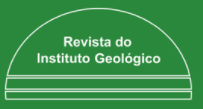Carbon isotopes applied to studies of climate and environmental changes
DOI:
https://doi.org/10.14295/derb.v42.735Keywords:
δ13C; Carbon; Isotopes; Paleoenvironment; PaleoclimateAbstract
Carbon is present in a large variety of natural reservoirs, such as rocks, soils, oceans and atmosphere, and is the major component of living organisms. The ratio between their two most common isotopes 12C and 13C, denoted as δ13C, is of great importance in the understanding of the dynamics and evolution of these reservoirs. The fractionation between 12C and 13C mainly occurs during photosynthesis, which preferentially incorporates 12C into organic molecules and controls δ13C values of large extents of the biosphere and other materials. For example, the isotopic signature of plants is transferred to soils and later to cave speleothems and/or sediments carried by rivers and deposited in the oceans. Another example is the photosynthesis performed
by marine algae, which affects the isotopic signature of seawater that is also transferred to carbonate shells of marine organisms, such as foraminifera. Thus, δ13C values from these materials (i.e., organic molecules, speleothems, foraminifera) are closely related to the climatic and environmental conditions occurring at their site of formation. In this review, we summarize the dynamics of δ13C in plants, soils, rocks and oceans to show how these carbon reservoirs can document present and past climatic and environmental conditions, and therefore, provide important information about biologic and geologic processes. The examples shown in this paper are mainly derived from paleoclimatic and paleoenvironment studies performed in the Brazilian territory and the adjacent ocean.
Downloads
Downloads
Published
How to Cite
Issue
Section
License
Copyright (c) 2021 Derbyana

This work is licensed under a Creative Commons Attribution 4.0 International License.
Política de Acesso Livre:
A revista Derbyana oferece acesso livre ao seu conteúdo. Toda a coleção da Revista é disponibilizada de forma gratuita em https://revistaig.emnuvens.com.br/derbyana e no Portal de Periódicos Eletrônicos em Geociências – PPeGeo (http://ppegeo.igc.usp.br), resultado de parceria entre a Sociedade Brasileira de Geologia e o Serviço de Biblioteca e Documentação do Instituto de Geociências da Universidade de São Paulo.




















